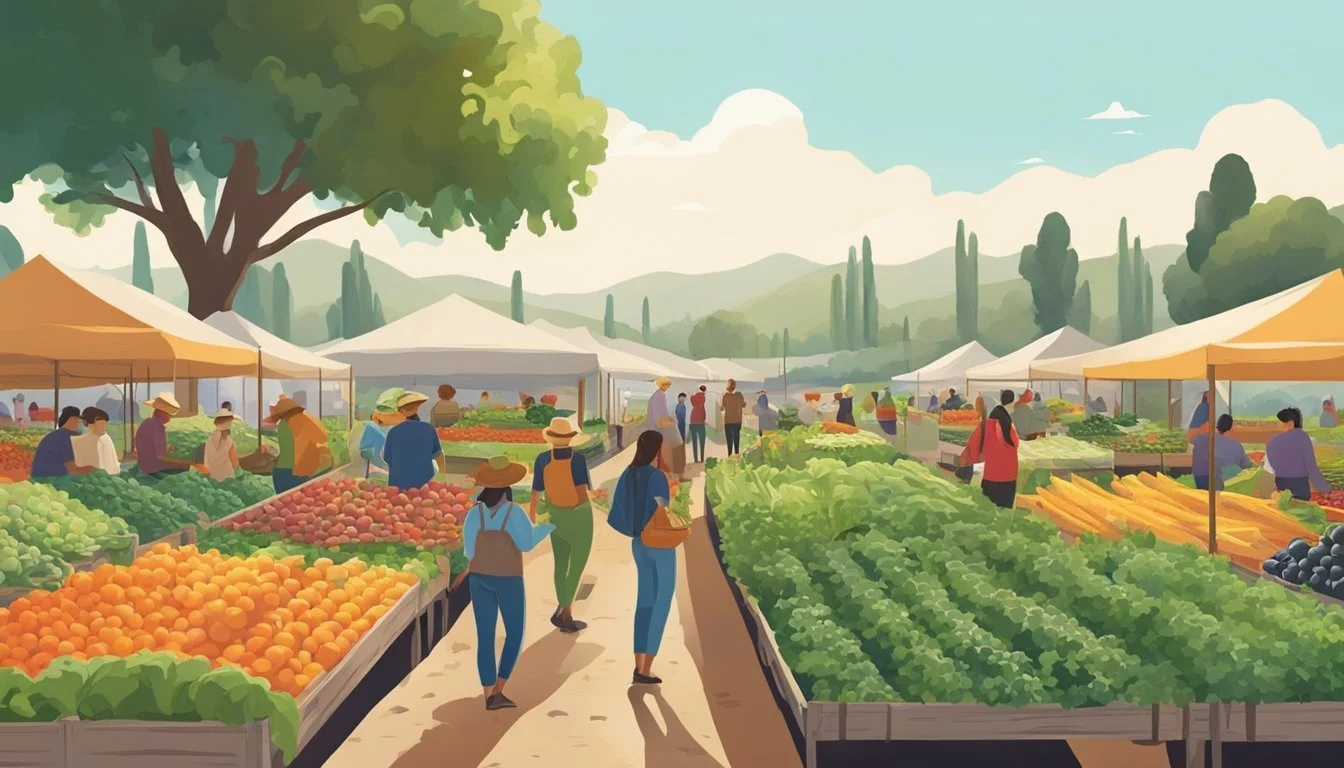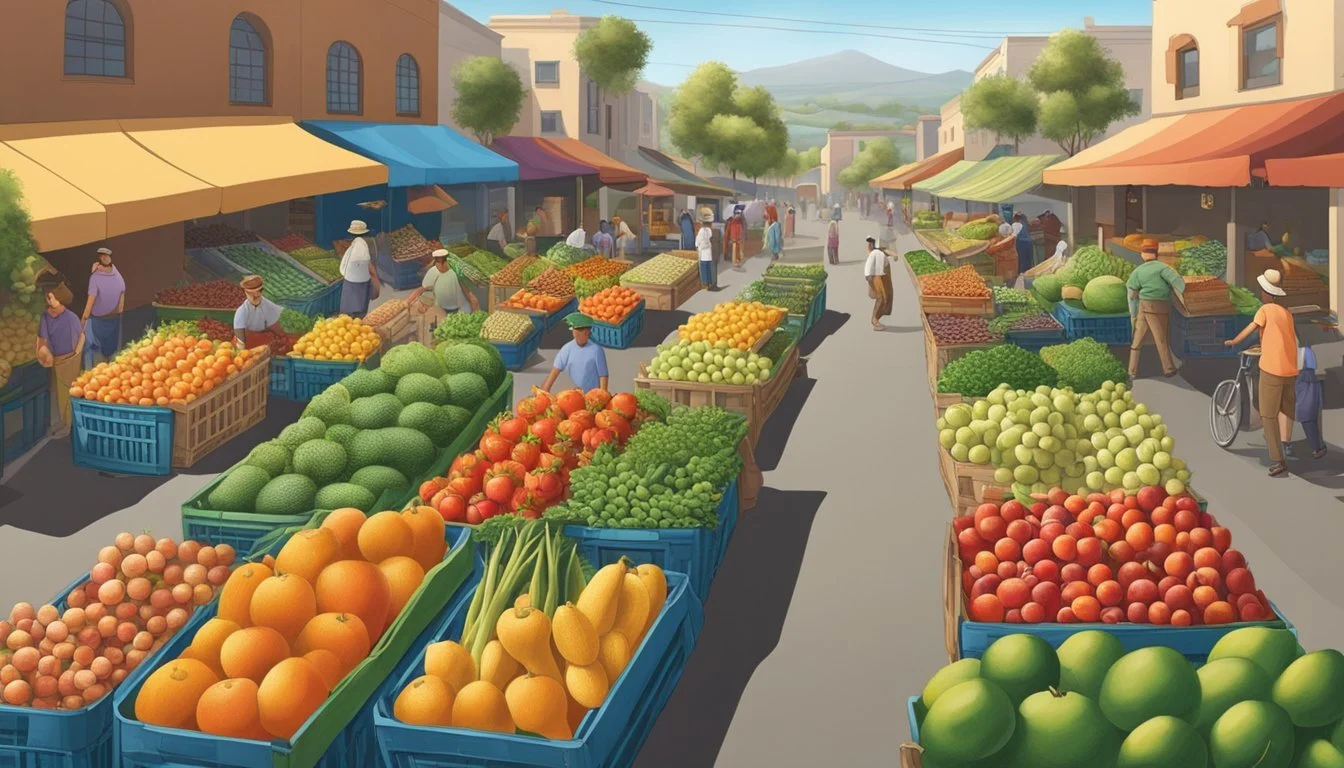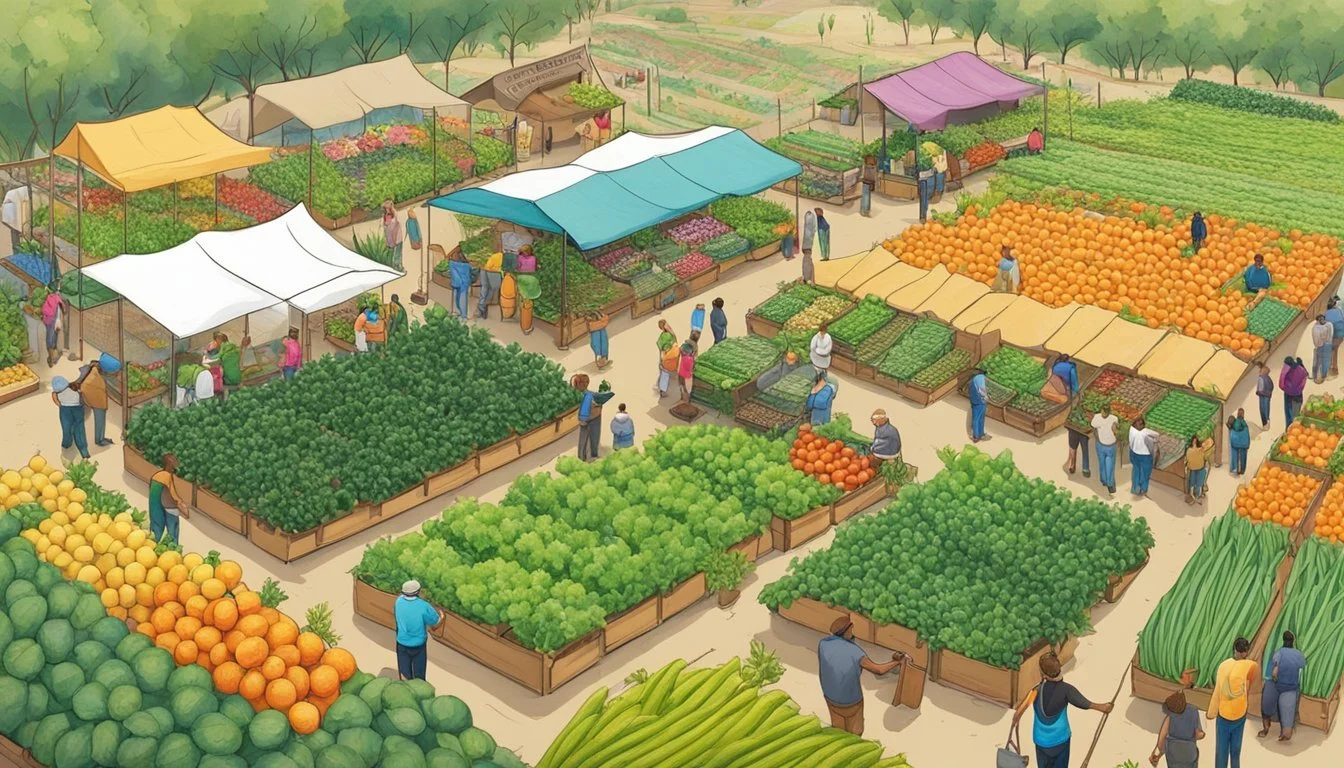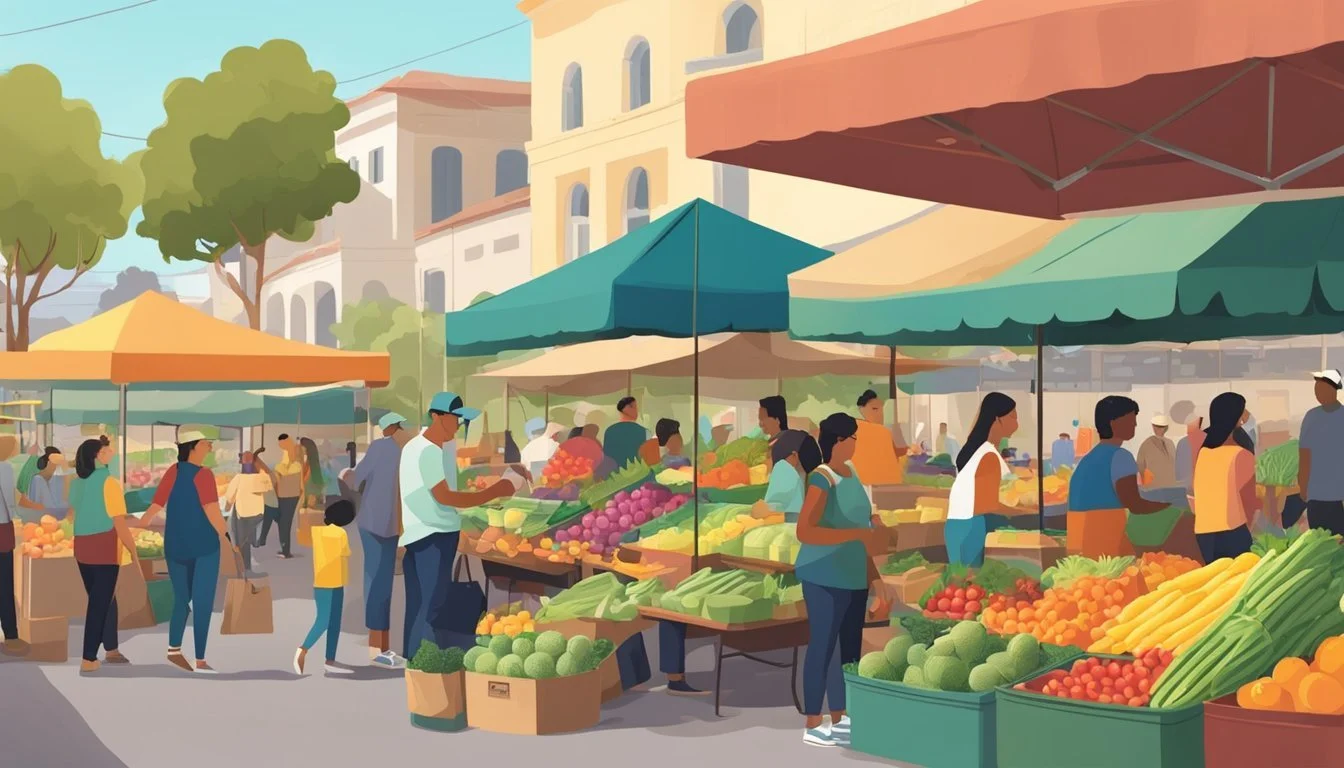Community Supported Agriculture (CSA) in Santa Ana, CA
A Guide to Local Farm Subscriptions
Community Supported Agriculture, commonly abbreviated as CSA, has seen a surge in popularity across various regions, including Santa Ana, California. The concept of CSA centers around a partnership between local residents and farmers, wherein consumers purchase "shares" of a farm's harvest in advance. This innovative agricultural model not only supports local farmers by providing them with upfront capital but also allows consumers to enjoy fresh, seasonal produce directly from their local farms.
Santa Ana, nestled in the heart of Southern California, hosts a variety of CSA programs that cater to the community's increasing demand for sustainable and locally sourced food options. Organizations such as the Salsa Cooperative Food Hub are actively involved in promoting urban agriculture and education, reflecting a broader commitment to environmental sustainability and community empowerment. By joining a CSA program in Santa Ana, members receive regular deliveries or pickups of a diverse array of farm products, fostering a connection with the source of their food and the rhythm of the seasons.
The promise of CSA goes beyond the provision of fresh produce; it's an investment in community well-being and health. Santa Ana residents who participate in CSAs are not just passive consumers; they become an integral part of a farming process that values ecological practices and equitable food distribution. They experience, firsthand, the tangible benefits of supporting local agriculture which includes, but is not limited to, enhanced food freshness, traceability, and the promotion of bio-diversity in their dietary choices.
Understanding CSA
Community Supported Agriculture, commonly known as CSA, encompasses a strategic partnership between local consumers and farms.
CSA Fundamentals
Under the CSA model, individuals become members by purchasing a share of the harvest. In return, they receive a regular allotment of farm produce, typically delivered weekly. This system ensures that members enjoy fresh, seasonal produce directly from their local farmers, fostering a sense of community and support for local agriculture.
Components of a CSA Share:
Fruits
Other farm products (occasionally): Eggs, honey, meat, or bread
By taking part in a CSA, members not only secure their source of fresh food but also engage directly in a relationship that benefits the local economy. They share in both the bounty and the risks inherent in farming, creating a palpable sense of investment and partnership.
History of CSA
The CSA model originated in Japan in the 1960s and made its way to the United States in the 1980s, finding a welcome audience among those who valued sustainability and eco-consciousness. Santa Ana, like many communities, has seen a growing interest in CSA, as it aligns seamlessly with contemporary movements towards supporting local food systems.
Timeline:
1960s: CSA concept inception in Japan
1980s: CSA introduction to the U.S.
This model of agriculture has since become a cornerstone in developing resilient, local food systems and nurturing direct farmer-consumer partnerships that are economically and environmentally sustainable.
Benefits of CSA
Community Supported Agriculture (CSA) programs in Santa Ana, CA provide substantial advantages, strengthening community bonds and health through a framework of local food distribution. Consumers earn the twin benefits of fresh produce and educational gains while farmers enjoy stable markets and reliable income.
For Consumers
Health: Consumers have access to fresh, seasonal produce that is often more nutritious than that available at traditional grocery stores.
Education: CSA programs often include opportunities for members to learn about sustainable farming practices, deepening their understanding of where and how their food is grown.
Local Food: Participation in a CSA ensures that the money spent goes directly to support local farmers, keeping the local economy robust.
Community: A sense of community is fostered as consumers often meet each other at pick-up locations or events, sharing recipes and tips.
For Farmers
Stable Market: Farmers benefit from a direct-to-consumer market, reducing the uncertainty of selling through intermediaries like grocery stores or farmers' markets.
Reliable Income: By selling shares of their farm's output before the season begins, farmers can secure a stable cash flow to cover initial operational costs.
Community Support: A reliable customer base from the community provides support and feedback, encouraging sustainable practices and experimentation with new crops.
Education: Through CSA, farmers can educate members on the challenges and rewards of farming, potentially inspiring new generations of agricultural professionals.
CSA Membership
Community Supported Agriculture (CSA) memberships in Santa Ana, California, are partnerships between local farms and community members. These memberships allow individuals to receive fresh, seasonal produce while supporting sustainable agriculture in their area.
How to Join
Individuals interested in becoming CSA members can locate a farm in Santa Ana, such as the Salsa Cooperative Food Hub, and express their intent to join by filling out a membership form, which is typically available online or at the farm itself. The farm may ask potential members to answer a series of questions to understand their preferences and to ensure a fit with the CSA's offerings.
Membership Responsibilities
Members commit to the CSA by purchasing a "share" of the harvest, which implies both benefiting from the farm's bounty and sharing the inherent risks of farming such as weather fluctuations and crop yields. Members are often expected to:
Pick up their share regularly at designated delivery sites.
Stay informed about farm updates and crop availability.
Participate in volunteer opportunities or farm events to foster community connections.
Cost and Payment Options
The cost of a CSA share varies depending on the farm's size, diversity of produce, and length of the CSA season. Payment is usually required upfront to provide the farm with necessary resources for the season's start. However, some CSAs, like Salsa Cooperative Food Hub, may offer:
Sliding scale pricing to accommodate different income levels
Payment plans to spread the cost over multiple installments
Subsidies or sponsorships for low-income members
Payment methods often include cash, checks, credit cards, or electronic funds transfer, and it's advisable for prospective members to inquire about which methods a farm accepts.
CSA in Santa Ana
In Santa Ana, Community Supported Agriculture (CSA) provides residents with options for fresh, local produce while supporting neighborhood farms and community education initiatives.
Finding Local CSA Farms
Santa Ana's residents have multiple CSA options where they can directly engage with local agriculture. These farms offer a simple way to access seasonal produce through subscriptions, where members receive a regular share of the fruits and vegetables harvested. One of the notable CSAs includes Salsa Cooperative Food Hub, located at 1505 E 17th St Ste117, which supports local farmers and provides hands-on experience in sustainable organic farming.
Crece Urban Farms Initiative
Crece Urban Farm, a project underscoring the importance of non-profit organizations in CSA efforts, plays a pivotal role in Santa Ana's community. It focuses on local urban agriculture, empowering individuals with the education to start and maintain their own gardens. The initiative reflects a commitment to sustainability and provides the community with educational resources centered on urban farming practices.
Community Engagement and Education
Community engagement and education are at the core of CSA programs in Santa Ana and the wider Orange County. These programs are not just about providing food but also fostering a powerful investment in community health and sustainability. Besides fresh produce, CSA members benefit from the various educational opportunities offered, such as workshops and events that aim to connect people to their food sources and promote eco-conscious living.
Santa Ana's CSAs represent an important asset to Orange County's food landscape, demonstrating a successful model of collaboration between farms and the local community.
Operational Aspects of CSA
In Santa Ana, California, Community Supported Agriculture (CSA) operates through a delicate balance of farming practices, distribution methods, and consumer outreach. These components are critical for maintaining a successful CSA that supports local farmers and provides fresh produce to the community.
Agricultural Practices
The CSA farm in Santa Ana focuses on the cultivation of a variety of vegetables and fruit to maintain a diverse offering throughout the season. The land is managed using sustainable techniques that aim to enhance soil fertility and biodiversity. Seasonal planting schedules are adhered to, ensuring a steady harvest of different crops at peak freshness.
Planting: Beans, carrots, tomatoes (Spring/Summer)
Harvest: Lettuces, berries, squash (Summer/Fall)
Harvesting and Distribution
When the harvest season arrives, produce is picked at its ripest to ensure the highest quality. Santa Ana's CSA then prepares boxes of these fresh goods for distribution. These boxes often contain a weekly supply of produce and are delivered through various channels, including home delivery or pick-up at designated local spots such as the farmers market.
Method 1: Home delivery
Frequency: Weekly
Transport: Eco-friendly options when available
Method 2: Pick-up at farmers markets/local spots
Locations: Multiple in Santa Ana
Schedule: As per market days
Marketing and Outreach
Marketing strategies are vital for the CSA's viability. They typically include a mix of online presence, farmers market stands, and community events. A robust online platform helps to schedule deliveries, manage subscriptions, and post updates about the farm's activities. Educational outreach at markets and local events fosters a connection between the farm and the community, encouraging new memberships and public support.
Online platforms: Website, social media
Event participation: Local food festivals, agricultural fairs
Common CSA Produce
Community Supported Agriculture in Santa Ana, CA, offers a rich selection of fruits and vegetables that vary with the seasons. Subscribers to local CSAs can expect fresh, high-quality produce grown in close proximity to their community.
Seasonal Availability
Santa Ana's climate allows for a diverse array of produce to thrive. Here is an overview of what members might expect:
Spring: Members can savor the crispness of lettuce, the tender leaves of arugula, and the earthy richness of carrots.
Summer: This season delivers peak abundance. Corn, tomatoes, and melons become plentiful.
Fall: The harvest continues with hearty vegetables such as kale and varieties of squash. This is also the time for grapefruit and navel oranges to make their appearance.
Winter: Even during the cooler months, Santa Ana CSAs supply citrus fruits like oranges, and continue to offer robust root vegetables and leafy greens.
Fruit and Vegetable Variety
The available varieties within Santa Ana CSAs showcase the region's agricultural diversity:
Leafy Greens: Subscribers enjoy a selection of greens, including kale, arugula, and various types of lettuce, all known for their freshness and nutritional value.
Root Vegetables: Carrots and radishes are common, appreciated for their flavor and versatility in the kitchen.
Fruits: Strawberry lovers rejoice in spring and early summer, while citrus aficionados can indulge in oranges and grapefruit come winter.
Additional Vegetables: Other staples frequently found in CSA boxes include a range of tomatoes and sweet corn, emblematic of Santa Ana's rich soil and ideal growing conditions.
By participating in a CSA program, residents support local agriculture and receive a share of the finest produce Santa Ana has to offer.
Supportive CSA Structures
Community Supported Agriculture (CSA) in Santa Ana fosters strong connections between farmers, consumers, and various organizations. Through these partnerships, CSAs provide more than just food; they offer a means for community engagement and support of sustainable agriculture.
Local Partnerships
Santa Ana's CSAs thrive due to robust local partnerships that create a network of support for the farming community. The partnerships often include a mix of businesses, educational institutions, and local government entities. Each partner brings unique strengths to the table, such as marketing channels, distribution logistics, or technical assistance. For instance, Cooperacion Santa Ana's partnership with Orange County Co-op Network exemplifies how a local network can bolster a CSA's reach and impact within the community.
Community Programs
Community programs are integral to Santa Ana's CSA frameworks. These programs might involve educational outreach or community events to raise awareness about the importance of supporting local agriculture. The Salsa Cooperative Food Hub is a prime example, as it not only offers CSA shares but also aids in fundraising efforts. Such programs are often publicized through social media platforms like Facebook, which serve as powerful tools for community engagement and promotion of CSA benefits.
Non-Profit Organizations
Non-profit organizations play a pivotal role in supporting CSA structures in Santa Ana. They often provide critical fundraising assistance, as well as technical support to optimize CSA operations. Non-profits can also act as intermediaries that facilitate the distribution of CSA shares to a wider audience, including those in underserved communities, thereby strengthening the impact of CSAs. Their contribution to the infrastructure of CSAs is invaluable, ensuring that both farmers and community members can sustainably benefit from the system.
CSA Innovations
Community Supported Agriculture in Santa Ana, California has spearheaded progressive methods and technologies to enhance the CSA model's growth and efficacy. Innovations range from integrating advanced technology to conducting meticulous research and development to ensure maximum yield and quality of produce distributed to CSA members.
Technology Integration
The integration of technology within the CSA framework has significantly improved operational efficiency and consumer interaction. The CSA Innovation Network leverages digital platforms for better communication between farmers and consumers. For instance, online subscription services facilitate the purchase of CSA shares with ease, allowing consumers to support local agriculture effortlessly. On the logistic side, tracking systems provide real-time updates on produce boxes, ensuring transparency and trust in the process.
Key technologies implemented include:
Mobile Apps: Enabling members to manage their subscriptions and view contents of weekly deliveries.
Databases: Helping farmers with crop planning and share management.
Communication Tools: Offering a direct line to farmers for feedback and inquiries.
These tools are instrumental in fostering a knowledgeable community that values the innovation and knowledge sharing which are cornerstone principles of the CSA model.
Research and Development
CSAs in Santa Ana do not only focus on distribution but also on the development of improved farming practices. They engage in research to ascertain the best seeds and cultivation strategies that are suitable for the local climate and soil conditions. This research leads to innovation in sustainable agriculture practices, preserving biodiversity and ensuring the health of the ecosystem.
Important research focuses include:
Seed Varietals: Selecting and propagating seeds that thrive locally and have superior flavor and nutritional profiles.
Sustainable Techniques: Developing methods to reduce water usage, manage pests, and improve soil health without relying on harmful chemicals.
Constant innovation and sharing of knowledge within the CSA network promote best practices and help members stay abreast of the latest developments in sustainable agriculture.
Extending CSA Impact
Community-supported agriculture in Santa Ana, CA drives significant advancements in local food systems by enhancing food sovereignty, expanding educational programs, and delivering socioeconomic benefits to the community.
Food Sovereignty and Security
Community-supported agriculture (CSA) programs contribute to food sovereignty by allowing consumers to take an active role in the production of their food. These programs ensure food security as families gain access to fresh, local produce. CSAs in Santa Ana address potential gaps in the conventional food distribution system, thereby empowering families to shape their food heritage. SNAP benefits are often accepted by CSAs, making healthy food more accessible to a broader segment of the population.
Education and Outreach
CSAs in Santa Ana provide valuable education and outreach opportunities. Through farm visits and participation in CSA programs, individuals, especially children, learn about sustainable farming and the importance of fresh produce for good health. This firsthand experience fosters a connection with the land and educates community members on agricultural practices that protect their heritage.
Socioeconomic Benefits
Participation in CSA positively impacts the socioeconomic status of community members. By supporting local agriculture, families help to sustain family-run farms and the local economy. In turn, this supports the health and viability of the local community. Furthermore, CSA memberships create a predictable income stream for farmers, improving their financial stability and the overall resilience of the local food system.
Engaging the Community
In Santa Ana, Community Supported Agriculture (CSA) initiatives actively engage the community through hands-on participation and educational events. They aim to foster a strong connection between residents and local food systems.
Volunteer Programs
Santa Ana's CSA projects rely heavily on the spirit of volunteerism to operate effectively. Volunteers contribute through various activities such as planting, harvesting, and distributing the produce. One notable cooperative food hub, the Salsa Cooperative, encourages residents to become integral parts of their operation, offering the chance not just to volunteer, but also to learn about sustainable agriculture practices, thereby promoting food self-determination.
Key Volunteer Activities:
Planting: Volunteers learn about crop cycles and planting techniques.
Harvesting: Hands-on experience in harvesting ensures fresh produce reaches CSA members promptly.
Distribution: Volunteers play a crucial role in packaging and delivering seasonal goods to the community.
Events and Workshops
Santa Ana's CSA organizers understand the importance of education in sustaining a healthy local food system. Thus, they often hold events and workshops designed to share knowledge and resources with community members. Workshops may cover subjects such as urban farming methods, nutritional information, and ways to prepare seasonal crops. Events not only serve as educational platforms but also strengthen community ties and encourage new memberships in CSA programs.
Frequent Workshop Topics:
Urban Farming Techniques: Practical advice on growing food in urban settings.
Seasonal Cooking Classes: Teaching how to prepare meals with the CSA's seasonal offerings.
Q&A Sessions: Allowing community members to ask questions and get more involved with local food initiatives.
Expanding CSA Offerings
In Santa Ana, CSA programs are evolving to offer a wider array of products and choices for their subscribers. These enhancements involve incorporating additional farm products and varying the types of produce provided.
Adding Value with Other Products
CSA programs in Santa Ana are adding value to their usual offerings. Subscribers can now often find more than just vegetables in their boxes. It's becoming common for CSAs to include items such as eggs, meat, and cheese. This diversification aligns with the growing interest in urban farming and the desire for a one-stop subscription service for a variety of fresh, local foods. Also, some CSAs have started to incorporate flowers and salsa into their weekly or bi-weekly boxes, enhancing the CSA experience with both edible and aesthetic products.
Eggs: Fresh from the farm, often pasture-raised.
Meat: Options like chicken, pork, and beef, raised with ethical practices.
Cheese: Handcrafted cheeses from local dairies.
Flowers: Seasonal bouquets that bring color and life to homes.
Salsa: Freshly made using ingredients grown right on the farm.
Diversifying Produce Selection
The selection of produce in Santa Ana's CSA boxes is reflecting a conscious effort to diversify. CSA farmers are curating a more extensive seasonal variety aiming to inspire subscribers' cooking adventures with a wider selection of fruits and vegetables. This initiative not only supports a balanced diet but also educates the community about the diversity of crops that can thrive through urban farming. Subscribers receive tips on how to use uncommon produce, turning each box into an opportunity to explore new flavors and recipes.
Vegetables: Kale, Carrots, Beets.
Fruits: Strawberries, Oranges.
Tips: Ideas for salads and smoothies.
Summer Box Example:
Vegetables: Tomatoes, Cucumbers, Bell Peppers.
Fruits: Peaches, Melons.
Tips: Recipes for grilling and fresh salsas.
Challenges in CSA
In Santa Ana, Community Supported Agriculture faces multiple hurdles that affect its stability and success. These include economic factors, operational and logistical challenges, and marketing difficulties, which all play crucial roles in shaping the viability of CSAs.
Economic Factors
Economic challenges primarily stem from the structure of the CSA membership model. Payment issues such as the upfront cost for members and timely cash flow for farmers are significant. Farmers often require early season capital to grow crops, which hinges on early member payments, thereby putting financial pressure on both parties.
Upfront Costs: Members pay at the beginning of the season, which can be a financial barrier.
Cash Flow: Farmers need consistent cash flow to manage their operations effectively.
Operational Logistical Challenges
Operational logistic challenges encompass everything from planting to delivery of CSA shares. Farmers bear the responsibility for crop planning, harvesting, packaging, and delivering shares, which requires a substantial commitment of time and resources.
Harvesting and Packaging: Coordination is required to ensure freshness and meet delivery schedules.
Distribution: Establishing efficient delivery routes that reduce costs and maintain produce quality is crucial.
Marketing Challenges
Marketing is a persistent challenge for CSAs as they must communicate the value of their shares while competing with traditional food markets. Significant effort must go into educating potential customers on the benefits of CSA membership and the responsibilities it entails.
Educating Members: It is essential to convey the seasonal nature of produce and the shared risks involved in farming.
Attracting New Members: Use of digital marketing, community outreach, and word-of-mouth to grow membership.
Future of CSA
The future of Community Supported Agriculture (CSA) in Santa Ana, California, is poised for strategic development influenced by identifiable trends and a commitment to sustainability.
Trends and Projections
Research indicates that the CSA model is evolving, adapting to the needs and preferences of consumers. In Santa Ana, CSA programs like Salsa Cooperative Food Hub have taken root, demonstrating a keen interest in locally-sourced, organic produce. Data trends suggest that while the CSA model has seen fluctuating levels of popularity nationwide, demand for organic, locally-grown food is on the rise. This could presage a resurgence or transformation of the CSA model as it adapts to market demands.
2012: Peak popularity of CSA in the U.S.
Post-2012: Noticeable decline in CSA participation.
Current Trend: Movement towards revitalizing CSA interest.
Sustainability and Growth
Sustainability is intrinsic to CSA's ethos, and it is pivotal for the long-term growth of these programs. Santa Ana's CSA models prioritize environmental responsibility and seek to establish a closed-loop system that supports both the local economy and ecological health. For CSA to thrive, continuous efforts in promoting education on organic farming and maintaining eco-friendly farming practices are essential.
Factors Influencing Sustainability and Growth:
Local Engagement: Increased customer education on the benefits of CSAs.
Sustainable Practices: Commitment to environmentally sound farming.
Organic Demand: Growing consumer demand for organic products.
CSA's future in Santa Ana relies on the balance between these factors, fostering a model that is both economically viable and environmentally sustainable.
FAQs About CSA
Community Supported Agriculture (CSA) in Santa Ana connects residents with fresh, locally-sourced produce through a membership-based system. Here, members can subscribe to receive various shares of produce, actively participate in a community-oriented food system, and ask questions to better understand the process.
Subscribing to a CSA
When considering a CSA subscription, individuals are essentially buying a share of the farm's harvest. Subscriptions usually operate on a seasonal basis and the cost can vary based on size and frequency options.
Types of Shares: Generally, shares include a weekly or bi-weekly box of vegetables, fruit, and sometimes other farm products.
Membership Cost: The price of membership will depend on the farm, the size of the share (small or large), and delivery frequency (weekly or bi-weekly).
Receiving Deliveries
Members can often choose between picking up their shares at a designated location or having them delivered directly.
Delivery Options: Depending on the CSA, there may be a range of pickup locations, or for an additional fee, a home delivery service.
Pickup Details: Pickup points are typically set on a weekly or bi-weekly schedule, and members are responsible for adhering to this timetable.
Getting Involved
Membership extends beyond just receiving produce; it includes being part of a community and contributing to the local food system.
Community Engagement: Many CSAs encourage their members to visit the farm, attend events, and engage with how their food is grown.
Volunteering Opportunities: Some CSAs offer the option to contribute time or resources, deepening the member's connection to agriculture and the community.
By joining a CSA, individuals in Santa Ana can enjoy fresh produce directly from their local farms while supporting sustainable agricultural practices within their community.














